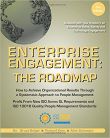Alex Mead, CX Executive Leader, on Why Customer Service Is so Bad
Despite all the talk about innovation in CX (Customer Experience), most observers say that customer service, in the US at least, is as bad as quality manufacturing was in the 1980s, before ISO 9000 quality standards and the concept of Total Quality Management took hold. Today, while quality in US manufacturing has steadily improved, the American Customer Service Index remains mired in the low 70% range. Alex Mead, Chief Customer Service Experience Officer for a global startup financial services fintech company, and a Senior Advisor to the Engagement Agency, explains why. Mead was a recent panelist on an EEA Youtube Show on Why Customer Service Is So Bad.

Anyone who follows
Alex Mead on LinkedIn knows he questions the value of the huge Customer Experience (CX) movement, even though he makes his living as a Chief Customer Service Experience Officer for a start-up whose name he cannot publicly disclose. “I can speak for the world, not just the UK or US, as I’ve been setting up new and improving existing customer service in Asia, China, Europe, Latin American and the US for years…The state of our customer service is woeful throughout the world, even though there are over 14 million customer experience professionals on Linked in worldwide.”
In fact, Mead thinks service is getting worse. “I’m even seeing declines in the customer service of Amazon, which has long presented itself as the world’s most customer-centric company. When the pandemic hit, Amazon stopped taking full responsibility for delays, blaming the shippers. You can’t do that. Companies have to take responsibility for service promises, even if it’s a logistics issue, and make it right.”
How can customer service be declining in an era of active social media feedback and customer management technology? “First, CEOs are often completely unaware of the reality of the real-world service experiences their customers are subjected to. On several occasions I’ve brought to life the reality in board meetings by sharing specific ‘horror stories’ and customer data, and it’s usually met with denial and disbelief.”
The second major cause, he says, “is the metrics typically shared with the CEO, things like Net Promoter Scores, show all is fine. However, NPS scores are often massaged to provide an ‘acceptable score’ or only used to survey customers that made a purchase, but not those that gave up because their buying experiences were so poor.”
Do Companies Build Poor Service into Their Business Models?
Similarly, “Too often meeting the ‘bottom line’ figures in terms of sales and profits are the core focus, with little discussion about lost sales opportunities or customers that have departed through bad service experiences.” In other words, most CEOs and CFOs build customer dissatisfaction into their budgets rather than addressing the fundamental issue, he says.
Mead believes the CX world has become fascinated with branding buzzwords and technology rather than addressing the fundamental issues of poor customer service. “I specifically asked my current employer for the title of Customer Service Experience Officer because my job is focused on the basic elements of customer service: a person needs an answer; wants to change an order; wants to know where a package is. Or maybe, customers don’t know how to use a certain product or want to return it. These are all Customer Service experiences, and every interaction is important. When things work perfectly, people don’t think about it. But when they fail, the entire customer experience is ruined.”
The problem for many companies is they confuse brand marketing experience with customer service experience. “For the brand and marketing people, it’s about making sure you tell me the good stuff, put out advertisements and campaigns, send me the right offers. It’s not about keeping the promises.” In the end, he adds, most customers want to see those promises delivered and experience great service when they have a problem, and that’s where most companies fall short, he adds.
He believes too many companies advertise that they ‘put their customers at the heart of everything’ without ever putting themselves into the customer’s shoes to test out these promises. “How many marketing executives test their own customer experience by going to the web site, trying to figure out how to solve a problem or who to call to get a problem solved? Or, once they call, finding out they are getting subjected to rigid bots, long hold times, uninformed or unempowered employees who shift them from one person to another with more long hold times in between. How many executives objectively experience their own marketing and customer service?”
Look at what even the largest companies routinely subject us to, he points out: “Customers want to get answers quickly and they want accountability. They want to solve problems on their own with an app, if possible, but if they can’t do that easily. They want to be able to talk to a knowledgeable person with the authority to sort it out. Instead, we force people to enter account numbers by a bot only to be asked for them again by agents. Or we get forced down a channel we don’t want to go and then have to reauthenticate ourselves again. Over 75% of chat sessions end with, ‘Sorry, I can’t help you.’”
Make Service Easy, Personalized, Intuitive and Contextual
What are the secrets of customer service success? As usual, it starts at the top. Mead says. “I won’t work for a company whose CEO is not fully committed to the economics of excellent customer service.” The goal, he says, is to make service “easy, personalized, intuitive, and contextual.”
He explains, “Make it mind-blowingly easy for the customer to find out where to get help on the platform they prefer. If you want to offer self-service, give them a personalized experience. You have to look at every process from the customer’s standpoint from every possible use case.”
A critical element is to effectively train, engage and fully empower staff to become customer advocates, “You have to give them the power to quickly put things right. That means giving employees the right to stand up and say ‘this process stinks,’ and the authority to resolve the issue. Why are we forcing people to provide the same information multiple times or making it take so much time to solve a problem?”
One of the hardest parts of the customer service experience job is to “have the courage to be consistent. You need to have one customer service infrastructure so that everything is on one screen. Employees should not be measured by the length of the call, as is too often the case, but on whether they helped the customer solve the problem. Did they sound engaged and caring?” Mead believes that a longer call with a customer service employee with a ‘concierge’ mindset can save multiple repeated calls and frustration caused by failing to address the problem in the first place. “Too many companies fail to make this important calculation.”
Many companies know how to create great service by offering concierge services to their platinum customers. “What they fail to see is all the business they lose by treating everyone else poorly. Take the case of a frequent business travelers who experience platinum service at one airline who for one reason or another must fly another carrier. Most likely they will be subject to poor customer service and will do everything they can to avoid that carrier.”
Avoid the “Bright Shiny Object” Syndrome
Technology is a critical enabler if used to enhance the customer service experience, rather than to simply lower costs. “I wonder whether some colleagues in the customer service space get caught up with all the different technologies, bots, artificial intelligence, etc., as bright shiny objectives to avoid the hard work of actually creating a concierge-like customer service experience in which customers can easily find the right person who has the authority and knowledge to rapidly resolve the issue.” When a company sincerely focuses on creating a seamless customer service experience, “it actually saves money and increases revenue. Unhappy people and customer service technologies that fail to talk with one another burn up customer service time and hurt reputations. High levels of customer satisfaction increase sales and loyalty, because people tell their friends and colleagues and are more likely to do business with you again.”
He concludes, “Companies are very much out of touch. They don’t get how badly broken it is, but times have changed. Those companies that fail to address their terrible customer service won’t be in business in five years, because customers have too many choices.” He adds, “I sometimes wonder if CEOs agree to be in a secret club, in which as long as they are all as bad as each other, then individually none of them look bad.”
Based on the sorry state of customer service experience, Mead suspects that many executives run their marketing based on the rule that 20% of their customers will do 80% of the business. “It does not occur to them that if they cleaned up their acts, they might get more business from the middle 60%.”
Master the “S” of Environmental, Social, Governance (ESG), A.k.a. Stakeholder Capitalism
The Enterprise Engagement Alliance at
TheEEA.org is the world’s first and only organization that focuses on outreach, certification and training, and advisory services to help organizations achieve their goals by fostering the proactive involvement of all stakeholders. This includes customers, employees, distribution and supply chain partners, and communities, or anyone connected to an organization’s success.
Training and Thought Leadership
 Engagement Digital Media and Marketplaces
Engagement Digital Media and Marketplaces
Video Learning
 Books
Books
Enterprise Engagement Advisory Services
-
Organizations of all types develop strategic Stakeholder Capitalism and Enterprise Engagement processes and human capital management and reporting strategies; conduct human capital gap analyses; design and implement strategic human capital management and reporting plans that address DEI (Diversity, Equity, and Inclusion), and assist with managed outsourcing of engagement products and services.
-
Human resources, sales and marketing solution providers profit from the emerging discipline of human capital management and ROI of engagement through training and marketing services.
-
Investors make sense of human capital reporting by public companies.
-
Buyers and sellers of companies in the engagement space or business owners or buyers who seek to account for human capital in their mergers and acquistions.
For more information: Contact Bruce Bolger at
Bolger@TheICEE.org or call 914-591-7600, ext. 230.

 ESM News Alert for the latest news. Subscribe here.
ESM News Alert for the latest news. Subscribe here.
